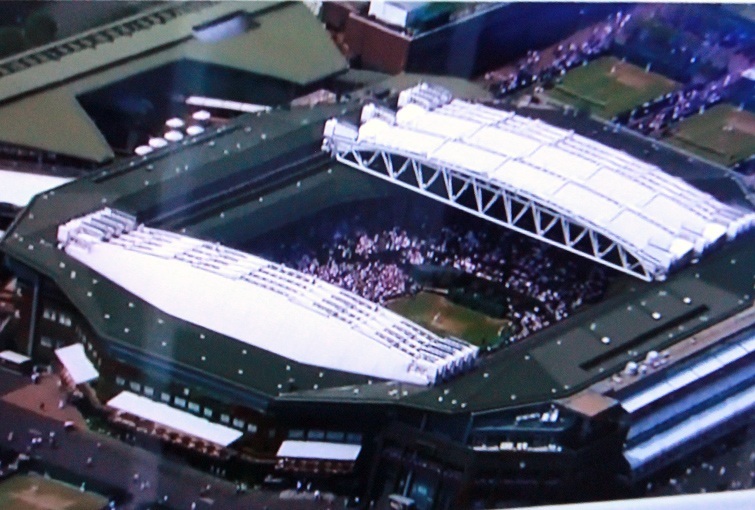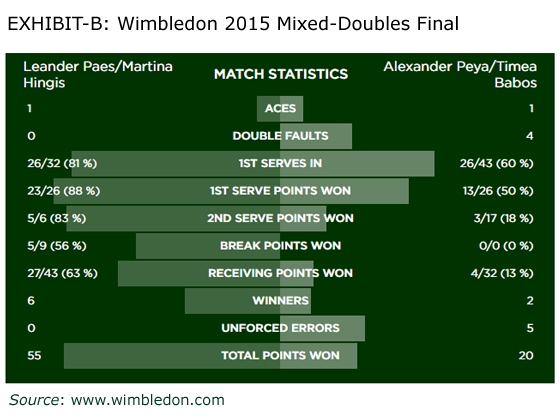Last Sunday, the men’s singles final at Wimbledon between Djokovic and Federer was an enthralling match. Federer had hoped to become the first man to win Wimbledon a record eighth time; and Djokovic seemed to have something to prove after his recent defeat at the French Open.
The mixed doubles final, also played later that afternoon, was relatively a one-sided affair. The Paes-Hingis pair staged a clinical performance to clinch the title by decimating their opponents within 40 minutes.
During the matches, the English commentator attributed Djokovic’s win to his skill, determination, power, and accuracy, and alluded to Federer as the ’33 year old tired opponent’. Interestingly, the same commentator (or it may have been another one) ascribed Paes–Hingis’ comprehensive win to their experience, homework, and coordination.
But why did Federer really lose, despite his stellar experience of ten Wimbledon appearances and near-perfect game? And how did the ageing pair of Paes (at 42 years) and Hingis (almost at 35 years) register such a convincing victory against a much younger team? So, what does it take to succeed at the highest level in sports? And what lessons, if any, can businesses take from Wimbledon?
The Centre Court at Wimbledon provides three crucial lessons for businesses to succeed:
1. Do your homework thoroughly. Federer’s serve is the key to his game; he tends to serve deep and aggressively goes for the kill on the return of the serve. During the semi-final clash with Andy Murray, Federer’s winning points came off 5 rallies or less (on an average); whereas Murray’s winning shots came from at least 8 rallies. Federer outplayed Murray winning more than 80% of points off his first serves.
While Djokovic’s own serves were lethal, he must have studied his opponent well and had perfected his returns too. He forced Federer to play more rallies by returning his serves into areas where Federer could not attack back. The longer the rallies continued, the farther Federer had to run, and the more he became prone to making unforced errors thereby strengthening Djokovic’s chances at converting them into winners. Djokovic’s most winning points came off rallies that lasted 8 or more shots.
EXHIBIT-A shows Federer committed unusually higher number of errors and had lower serving percentages against Djokovic as compared to those against Murray.
Similarly, companies operating in the marketplace must thoroughly understand their competitors. Companies must first comprehend how their serves (like introduction of new product, feature, or category) are going to be hit back by their competitors, and then plan their strategies based on those insights. If the retaliation is weak, the market leader wins the market share; whereas if the competitor does tit for tat, then the market leader is forced to choose between carrying on the duel (with further investments) and conceding the share to the competitor. While this is true in all industries, it is most evident in oligopolistic industries like FMCG, where there usually are two dominant players. For example, similar duel happened between P&G, which introduced Crest fluoride toothpaste in 1955, and Colgate-Palmolive, which had launched the world’s first commercial toothpaste.
2. Execute well. Djokovic executed his plan [to play long precision shots] perfectly. Many of his winning shots were executed so accurately that they scraped the outsides of the baseline and the sidelines.
In the mixed doubles final, Peya and Babos showed lack of coordination early in the game by crossing each other’s paths and getting mixed-up in returning shots. On the contrary, Paes and Hingis displayed an absurdly good performance by hitting powerful returns and playing deep cross-volleys at the nets. EXHIBIT-B displays their high serving percentages (in the 80s) and zero errors, which reveals a clean and flawless execution.
In business context, perfect execution of strategies is a pre-requisite to achieving long term success. There are innumerable examples of brilliant businesses going dud due to botched executions. Kodak, despite inventing the core technology in the digital cameras, failed to execute the strategy and went bankrupt. Few other examples of companies that fell due to failed executions are Atari, Research in Motion, and Woolworths.
3. Play to Win. The two finals played at the Centre Court made this third lesson very evident. In men’s singles, Djokovic lost the second set in tie-breaker because he seemed content to passively return Federer’s serve playing from outside the baseline. He just didn’t appear to be playing to win and that cost him the set.
However, the brief rain gave him an opportunity to clear his mind and bring back his focus on winning. In the third set, there was almost a different – calmer and more focused – Djokovic playing within the baseline only to win.
Likewise in the mixed doubles, Hingis and Paes were so focused on winning that they were actually enjoying the game right from the word go. Every rally and every return was confidently played by them to win the point (and eventually the title).
This is how great businesses compete too – to win! They take bold steps and confident actions in planning and executing their strategies. They strive very hard to grasp the real needs of their customers. They go all out in devising solutions that they know will address the real needs of their customers. They leave no stone unturned to market their offerings. For example, Steve Jobs was so badly persistent on winning that he stretched himself and his team members to no measures.
Djokovic summarized this point well when he said in the post-match conference,
“I am gonna [sic] have to win, he’s not gonna lose.”
References:
www.wimbledon.com
John A. Quelch, Jacquie Labatt-Randle: Colgate Max Fresh – Global Brand Roll-Out.
Related Posts:
- Two Finals, Two Ties, and the Common Winner
- Why do Businesses hire Management Consultants?
- Competitive Advantage: Do you have one? Is it sustainable?
<– Strategic Transformation Part-2
Data Science: The next frontier for business competitiveness (External: CSI) –>
You can also subscribe to our blog – Our Perspectives – to receive interesting articles and tips in email. We would love to read your perspectives and comments on that.
Do follow Veravizion on LinkedIn, Twitter, Facebook, or Google+ to receive easy updates.



2 Comments
Sourabh
July 17, 2015 at 8:09 pmHi, I read the article and in fact found it quite an interesting analogy between business and game.
There is learning in every facet of life. It’s just that we need to open our mind and observe.
Thanks
Praveen
July 19, 2015 at 4:30 pmSourabh,
Completely agree with you on that.
Cheers!